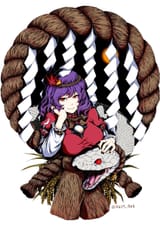>>50060074
The IRL Mishaguji lore goes something like this:
In times that predated the arrival of the Yamato mythology, people in Suwa believed that something called Mishaguji dwelt in the heavens. It was apparently more of a "thing" than a deity, a kind of life force or energy. Some have found analogies with the Polynesian concept of mana, and in other places of Japan the kami are sometimes thought to descend from the skies in similar manner.
Once in a year, if proper rituals were conducted, it was thought that the Mishaguji would descend down from the skies in massive amount and "communicate" have sex with a spirit serpent called Sosou. After this, the Sosou would "swell in size and become enormous" get pregnant, dig tunnels under Suwa and enrich the land and make it fertile.
Over time Mishaguji, who was apparently thought to be invisible, came to be represented as it's more visible manifestation, the giant Sosou snake. As centuries passed, the Yamato conquered Suwa and first introduced their mythology, and later Buddhism. The associations between Sosou and Mishaguji changed, people started to conflate the two to a degree where Mishaguji became represented as snakes. These depictions can be to this day be found in things like the Mishaguji stones in Suwa, which often have snakes or spirals carved to them.
As life was hard in Nagano, and Japanese culture generally doesn't have a clear good/evil duality going on, it was thought that the Mishaguji would cause famines and curses if they were not treated properly. The Yamato likely had an interest in highlighting the "curse god" aspect of Mishaguji to drive their own agenda. There's nothing particularly curse-heavy about old depictions of Mishaguji, as all deities and deity-like forces were thought to curse people if mistreated.
In Japan, snakes are generally speaking considered a very common manifestation of the various kami. Because of that, elements of other snake kami and dragon myths started to be weaved into Suwa mythology. These include the legend of Hashi Saburo turning into a serpent while visiting underworld and Takeminataka no Mikoto turning into a serpent or dragon after his arms and legs were cut off. Other serpent-associated deities which were associated with the Suwa mythology were the Ugajin and Benzaiten. Both of these figures receded to the background after Buddhism and Shinto were forcibly separated.
Suwako being a frog comes from lore associated with Ugajin, a really complex and convoluted entity blending Japanese, Chinese and Buddhism traditions. In the case of the Suwa, the Ugajin was associated with the kami who subdued the local monstrous frog or toad deity, Moreya. The frog deity was seen to represent various bad qualities like greed and ignorance, and by subduing the Moreya deity, these qualities were transformed into more enlightened ones. This is a mix of Yamato hagiography and Buddhist missionary work. In parallel, there was of course the tale of Takeminataka no Kami, sometimes seen as a serpent, sometimes as a human, subdying the Moreya deity. So it's kind of like two versions of the same story, one from a Buddhist POV and one from Imperial lineage POV.
Suwako-sama represents the various indigenous beliefs of Suwa, and Kanako-sama represents the various Yamato-introduced beliefs. However, over centuries these have become completely intermingled, and it's very hard even for historians to pick out the exactly development of local mythologies. The Suwa Grand shrine long since developed it's own distinctive identity, and what was once introduced by the imperial core has abandoned it. The last lingering remnants of this is the Jinja Honcho association of shrines, and Suwa Taisha is not part of it. Suwa faith has truly become a completely hybridized thing of it's own. That's why Suwako-sama and Kanako-sama are so intertwined. The snake controls the frog, but the frog controls the snake. The official front is of Yamato mythology, but behind it are local beliefs.
